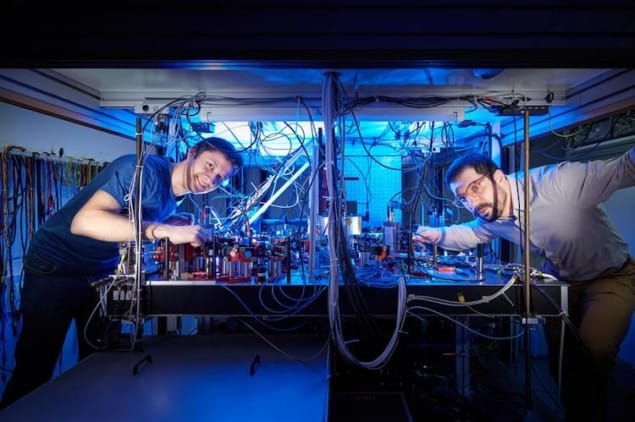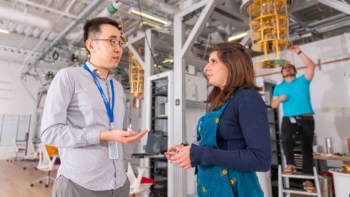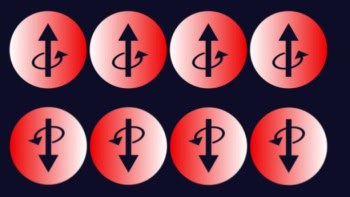
Complex quantum operations obey a “speed limit” of around 17 millimetres per second, say researchers led by physicists at the University of Bonn in Germany. The team obtained this result by working out how quickly they could transport an atom between two points while still preserving the information contained in its quantum state. The experiment, which required the team to transport the atom in a series of accelerating and decelerating sequences, could help optimize speed and accuracy in applications such as quantum sensing and quantum computing.
The concept of a minimum time or path to complete a certain process was put forward as long ago as 1696 by the Swiss mathematician Johann Bernoulli, whose famous brachistochrone problem involves determining the shape of the wire that allows a bead to slide down it in the least amount of time. While physicists know the solution to the brachistochrone problem for simple, two-level, quantum systems – that is, the fastest path connecting these two states – they run into problems for more complex, multilevel, quantum systems, like the ones on which most quantum computers are based.
Conveyor belt of light
In the new work, Andrea Alberti at the University of Bonn’s Institute of Applied Physics and his colleagues began by making an optical trap using two overlapped (superimposed), counterpropagating laser beams. The superimposition (or interference) of the beams creates a lattice, or standing wave, of light that contains a sequence of crests and valleys that are initially static. The researchers then loaded an atom of caesium-133 into one of the valleys and used a microwave field to cool it to its lowest (ground) vibrational state. In this state, the atoms can be described as a wave of matter that behaves not like a billiard ball but more like a liquid, Alberti says, and it oscillates with the smallest amplitude possible.
To transport this liquid-like atom, the researchers set the standing wave in motion, which displaces the position of the valley so that it moves as far as its nearest neighbour. They could vary the speed of this motion and track it on the sub-nanometre scale using a fast polarization synthesizer. This set-up gave them the flexibility they needed to transport the atom at both constant and varying speeds.
The goal of this experiment was to transport the atom wavepacket over a distance 15 times its size (a total of roughly 0.5 microns) in the shortest possible time, without the atom “spilling out” of the valley. Under these conditions, the atom arrives at its destination in the same energetic state in which it began. Conserving this state, which is fragile because it is sensitive to disturbances in its environment, means that any information stored in this state is not lost – a prerequisite for quantum computing.
Transport fidelity
To test their technique, Alberti and colleagues measured the atom’s transport fidelity – a parameter that characterizes how similar the initial and final states of the atom are. They found that they achieved better fidelities when the atom was transported at different accelerating and decelerating speeds. These variations, or “wiggling”, effectively cancelled out the effects of the transitions to the several intermediate states the atom had to go through as it travelled.
Such wiggling, which ensures that the atom is in the ground state when it reaches its final destination, does not occur in simple two-quantum states in which the start and end destination of the atom are very close to each other. In this case, explains Alberti, the matter waves of the atom at both locations overlap and the atom can be transported to its destination in one go – that is, without having to pass via any intermediate states.
He likens the wiggling to a waiter carrying an entire tray of half-full champagne glasses to a table at top speed without spilling a drop. In his analogy, the tray is the optical trap and the champagne the caesium atoms. When the waiter walks quickly, he slightly tilts the tray so that the champagne does not spill out of the glasses. And when he slows down again, as he approaches the table, he tilts the tray in the opposite direction. “Only when he has come to a complete stop does he hold it upright again,” Alberti explains.

Optical conveyor belt moves ultracold atoms into hollow optical fibre
“Anyone who wants to transport atoms from one position to another must be as skilful as the waiter, but even then, there is a speed limit that this transport cannot exceed,” he says. Indeed, the researchers calculated that the transport fidelity was best when the average speed of the transported atom was below around 17 millimetres/second.
The work, which is detailed in Physical Review X, has implications for quantum computing, Alberti says. Because quantum states are fragile, they last only a very short time (known as their coherence time). That makes it important to pack as many computational operations as possible into that short interval. “Our study reveals the maximum number of operations we can perform in this time and thus make optimal use of it,” Alberti concludes.



